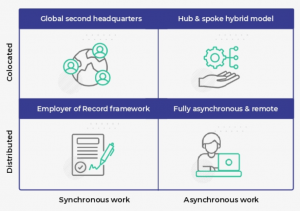In the last couple of years, we’ve all become equally familiar with phrases like “war for talent” or “the Great Resignation” of the “Great Reshuffle.” But what’s really happening? Let’s use numbers to put things into perspective:
- Over 85 million jobs would be unfilled by 2030, leading to a global revenue shortage of as much as $8.5 trillion, with the shortage of high-tech workers alone accounting for a loss of $162 billion.
- The talent shortage in the U.S. has tripled in the last decade, with as many as 69% of employers struggling to fill positions.
The U.S. is struggling with an acute shortage of skilled talent…
Meanwhile, the cost of hiring in the US has increased by the biggest margin since 2001, mainly due to an increase in wages and benefits. The employment cost index (ECI) surged 1.3% in Q3 2021 after rising 0.7% in Q2. This marks the largest gain in the last 20 years!
Employers today are facing the most brutal talent market in history, and there are multiple reasons for this.
Baby boomers are bidding adieu
One of the biggest factors contributing to this decrease in the supply of skilled workers is the accelerated retirement of Baby boomers. Nearly 30 million Boomers retired in the third quarter of 2020, leaving a large gap in the pool of skilled labor. While this was planned retirement for a part of the population, many Boomers retired early due to jobs lost during the pandemic.
Shortage of skilled workers in the younger generations
A large chunk of this shortage is simply demographic – think Japan or many Scandinavian nations, where the rate of birth has remained relatively low for decades. As a majority of Baby Boomers move out of the workforce by 2030, there will simply not be enough skilled workers from the later generations to fill this gap or invest the time and training that many highly skilled jobs require.
Work motivations have changed drastically
Skilled workers today know that they are a scarce commodity, and are not scared of using this as leverage. Professionals today want a significant increase in perks and benefits, better work-life balance, and greater flexibility and autonomy. 97% of respondents would choose some form of remote work in their lives, with 24% agreeing to take a pay cut in order to work remotely.
Professionals in the younger generations are leading the “Great Reshuffle”, with 87% of GenZ professionals in India planning to switch jobs in 2022. The fact that switching jobs does pay is a further incentive. Professionals who chose to switch their jobs got an average salary increase of 14.8%, with workers between 25 and 34 receiving the highest wage increase.
…and there is only one solution – global teams
According to Talent500’s recent survey, 89% of tech professionals would choose to work remotely for some part of their work week. This exponential demand for remote work opportunities also means that employers now have a chance to tap into a pool of talent that is global and limitless. Empowered by technology and the competitive cost of hiring, some of the biggest companies in the world are choosing to hire highly skilled professionals from different parts of the world and build global teams.
Different models of global teams

As companies rethink the most viable and profitable models of location-independent work, there are 4 major types that have emerged ~
Global capability centers
A GCC or a global capability center is a second, mirror team in a different location, which is generally an offshore tech hub that functions as an individual unit in itself. It mirrors the culture, setup, processes, and governance of the home office while giving the company access to extremely skilled talent at competitive costs. Simultaneously, it also enables the company to penetrate a completely new geographical market by accessing the local talent there. The cities of Sao Paolo, Mexico City, and Buenos Aires are emerging as the hottest tech hubs of LatAm, with Easter Europe and South Asia following suit. India is touted as the Global GCC capital, accounting for 45% of the world’s GCCs, generating an annual revenue of USD 33.8 billion in FY20.
At Talent500, we have helped companies across a multitude of industries, ranging from retail stalwarts like Giant Eagle, Advance Auto Parts, 7-Eleven, and Northern Tool + Equipment, to aviation giant Delta Air Lines setting up their GCCs in India.
Cluster offices/ hub & spoke model
Post-pandemic, a large part of the working population all over the world chose to move to the suburbs or their hometowns to cut costs. Cities like Miami, Austin, and Lisbon are emerging as fast-growing tech hubs, offering a better quality of life combined with a low cost of living. In this setup, the company operates a centralized main office – the “hub”, with more localized satellite offices, the “spokes”.
Following the hub and spoke model, companies like Adyen and MineralTree have chosen to set up their own offices in India with hiring assistance from Talent500.
Employer of record model
For businesses looking to expand globally and access a wider pool of skilled talent without the hassle of setting up a new entity, Employer of Record (EOR) is the solution. The EOR steps in to manage all the legal and operational requirements of building a global workforce for its client companies, from hiring and management of payrolls, to taxation, benefits, and legal compliances in a foreign country.
The EOR model has worked tremendously well for companies like Nike & Space and Time, as well as many upcoming financial product companies like SaaS leader Chargebee, Peach Payments, and Servify with Talent500 acting as their employer of record.
Fully remote
Completely location independent, companies that are fully remote do not have any physical offices or headquarters. Team members telecommute from different parts of the world, working across multiple countries and time zones. With the U.S. seeing a 96% increase in the number of fully-remote employees, it is evident that this model has become immensely popular post-pandemic.
Globally renowned companies GETTR, GitLab, Automattic, Atlassian, and Buffer are fully remote, distributed organizations with no central office.
Top talent hubs to tap into across the globe
The biggest advantage of global teams is the ability to hire superlative talent at a highly competitive cost. Ranging from Eastern Europe and Latin America, to Southeast Asia and parts of Africa, these regions offer an abundance of highly skilled talent, at substantially lower cost of acquisition.
Leveraging the superlative talent in the LatAm region
Colombia
The Columbian IT sector specialises in catering to the ever-growing demand for services required for custom software products such as application development, game development, and mobile app development. The country’s VAT exemption brings in a substantial amount of foreign direct investment, thus supporting IT infrastructure. The average annual salary for a software developer in Columbia is COL$43,247,704, or USD 9900, a highly competitive amount even at a global level.
Argentina
Argentina’s emphasis on higher education and technical skills makes it among the top countries offering niche skills in AI, cybersecurity, cloud computing, Internet of Things, and application programming interface. A 75% tax rebate for startups, and a Teleworking Law makes Argentina a highly preferred destination for hiring remote workers. With only a one-hour difference from the U.S. time zone, working with Argentinian developers in real-time is a big advantage.
Capturing Europe’s tech expertise
Turkey
Free technical education at public universities is a huge contributor to Turkey’s thriving tech population, with about 8.4 million students graduating every year.
Its close proximity to the European time zones (local time is CET+1 and GMT+2) makes it the ideal talent hub for distributed teams. The ease of availability of niche skills like C#, Java, Node.JS, .NET Core frameworks, and React, makes it one of the most popular destinations for hiring remote technical talent.
Poland
The Harvard Business Review ranked Poland 5th among the most tech-skilled labor markets in the world, housing as many as 430,000 IT specialists. Poland consistently ranks as one of the top three countries with the world’s best programmers, known for their technical expertise, code quality and general proficiency with English.
Building cost-effective tech teams in Southeast Asia
India
The emergence of a young and dynamic workforce is a major catalyst in making India one of the most popular destinations for hiring remote tech professionals. The Global Startup Ecosystem Report of 2021 has ranked Mumbai and Bengaluru amongst the world’s top startup hubs, pegging the valuation of India’s tech industry at a whopping $200 billion. Tech professionals in India are known for their expertise with skills like Blockchain, IoT, cybersecurity, machine learning and data science, combined with excellent spoken and written English.
Vietnam
Based on TopDev’s 2021 IT market report, the total number of developers in Vietnam (as of Q1/2021) was 430,000 IT developers, and over 55,000 graduated IT Students from over 153 IT institutions per year. The startup scene in Vietnam is on pace to be the region’s next tech hub; funding reached $2.1 billion in 2021, up from just $48 million in 2017. Vietnam is attracting top tier Silicon Valley venture capitalists, including Goodwater Capital LLC, Accel Partners LP and Altos Ventures Management Inc.
Watch out for these emerging tech hubs
Kenya
According to Findeable’s 2021 Global Fintech rankings, Kenya takes the top spot among African countries boasting 51 tech hubs and an increasingly connected workforce that continues to gain the attention of global VC interest. In a world experiencing digital transformation of its industries, Kenya—a country with an average age of 17—is now able to use technology to catapult into a different league.
Azerbaijan
Post-pandemic, the IT-outsourcing market has grown tremendously in the country thanks to governmental investment in IT infrastructure and internet access. The opening of the Google Technology Users Group in Baku has brought in some of the biggest tech companies to the country. A major factor in establishing Azerbaijan as an outsourcing hub is its highly competitive cost of hiring and talent acquisition. According to Glassdoor, the average software developer salary in Azn 2000, or 1200 USD.
Wondering which country might be the most conducive to building your global team? Find a point-wise comparison here.
Companies of all sizes are struggling with an acute shortage of skilled talent, with Gartner reporting an increase of 10% in the rate of attrition in a single year. With the ever-increasing cost of hiring and an employee-centric talent market, businesses can no longer afford to restrict their hiring strategy to a 30-mile radius.
Be it in any industry, across any part of the world – successful business leaders understand that leveraging the power of a global team is the only way to meet their hiring needs.
At Talent500, we understand that the transition to location independent working is a multi-layered process involving numerous stakeholders and factors. Our team of experts and network of highly skilled professionals are here to help you build your global team in over 50 countries. Ready to take the first step? Set up a consultation with our team here.






Add comment